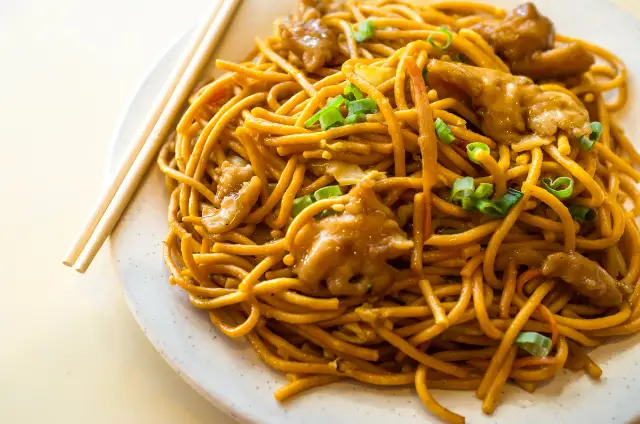Noodles are a great source of carbohydrates and fiber. They are a great staple food low in saturated fats and very popular in Northern China (Eight Culinary Traditions of Chinese Food), where wheat-based dishes are more common than rice-based ones. Chow mein and lo mein are the most popular noodle dishes widely available in American Chinese cuisine. (American Chinese Food Origins)
But what is the difference between Chow Mein and Lo Mein? The simple answer is the noodles and cooking methods. It’s widely assumed that the main distinction between chow mein and lo mein dishes is the type of noodles used. People come to this conclusion because chow mein noodles are delightfully crisp while lo mein noodles are silky smooth. Actually, what makes them different is how the noodles are prepared, not the type of noodle used.
“Mein” is simply the Chinese word for noodles. Noodles can differ significantly in terms of how they’re prepared and cooked, the ingredients, the type, and the thickness of the noodles. In this article, we are going to provide a breakdown of what chow mein and lo mein is, the culinary contrasts, and which is better.
What Is Chow Mein?

Simply put, chow mein literally means stir-fried noodles. It is also known as “twice-browned” noodles as the noodles in chow mein are fried on both sides until they turn brown. In the U.S., Chow Mein is usually a stir-fried dish containing noodles, meat such as chicken, pork, or beef, onions, and celery. Sometimes meat is substituted with shrimp or tofu. Vegetarian or vegan Chow Mein has become increasingly popular. There are mainly two types of chow mein dishes:
- Steamed chow mein: noodles that have a rounded shape are initially flash-fried, then stir-fried and tossed with a variety of vegetables, including onions and celery as well as carrots, cabbage, and mung bean sprouts. It is usually mixed with light soy sauce before serving.
- Crisp chow mein: sometimes referred to as “Hong-Kong” style, crisp chow mein is a pancake-like dish, in which the noodles are pressed flat while frying and any additional ingredients and sauces are layered on top of the noodle pancake. It usually contains onions and celery and features a thick sauce that turns the dish brown.
What is Lo Mein?

Lo Mein is called Lao mian in the Cantonese dialect. The two words literally mean tossed noodle. The noodles in this dish are thin and usually made of egg, which gives the noodles a more elastic texture. The noodles that are boiled are usually cooked until they are al dente or a little softer. Then it’s usually tossed with vegetables, meat, and sauce. Vegetables such as bok choy and cabbage are often added as well as meats like shrimp, roast pork, beef, or chicken. A vegetarian version is also common, and the dish is frequently enjoyed with just vegetables. There are a few types of lo mein dishes:
- Chicken Lo Mein: chicken strips are fried up quickly and added with all chopped vegetables to the wok.
- Beef Lo Mein: marinate a whole steak with soy sauce, ginger, honey, and balsamic vinegar. Then cut it into thin strips and toss with the noodles and vegetables.
- Shrimp Lo Mein: once the noodles are cooked and ready to drain, quick-tend the vegetables and shrimp, then whisk in the sauce and serve.
- Pork Lo Mein: marinate (not drown) pork stips to prevent them from steaming in the cooking process. Then mix with noodles and vegetables.
What’re The Differences Between Chow Mein And Lo Mein?
Before we look at the differences, let’s see what chow mein and lo mein have in common. Both of them use Chinese egg noodles — wheat flour noodles with egg added. The noodles are boiled first because they need to be softened before cooking. Even though the ingredients are very similar but the preparation is completely different. The fundamental difference between the two dishes is in the type of noodle and cooking methods.
#1. Noodles
– Chow Mein:
Chow mein noodles can be flat or round, fresh or dried. Dried noodles are parboiled in boiling water for 5 to 6 minutes before using, while fresh egg noodles only need to be boiled for 2 to 3 minutes. The exact amount of cooking time will depend on the thickness of the noodles. With either the fresh or dried noodles, be sure to boil them until they are just cooked but not too soft. Drain the noodles before they’re completely cooked, then press into a skillet and fry crisp in hot oil. Chow mein crispy noodles are fried into a nest or pancake after a partial boiling. Chow mein noodles are a deliciously crisp addition to the top of your vegetables and sauce.
– Lo Mein:
Fresh egg noodles (preferably about 1/4-inch thick) are best for lo mein. Lo mein usually uses fat, round, and chewy noodles. If Chinese egg noodles aren’t available, Italian pasta such as fettucini or linguini makes a handy substitute. Lo mein noodles are just boiled or parboiled until done and mixed with the vegetable, protein, and sauce mix. They are often (but not always) thicker than chow mein noodles.
#2. Cooking Method
– Chow Mein:
Chow mein is fried noodles in essence. Chow Mein Noodles are par-boiled or soaked in hot water before stir-frying in the wok. The stir-frying process completely cooks the noodles. With more oil, you can make the chow mein noodles more crispy. You fry them separately into a “noodle pancake” and then pour the stir-fried meat and vegetables over the fried noodles. Another cooking method is to stir-fry the noodles with meat/poultry and vegetables together. Chow Mein is a dry noodle dish without sauce
– Lo Mein:
Lo mein means tossed noodle and is a blended dish. You just toss the noodles with sauce and the ingredients to let the flavor soaked in, so the noodles have a nice chewy texture. Lo Mein noodles are fully cooked before they are mixed with meat, vegetables, and sauce in the wok. They are mixed and tossed, not stir-fried. These noodles are added to the end of the stir fry with tons of sauce, which is the real star of any lo mein dish. it’s not surprising that lo mein recipes often use more sauce than chow mein recipes.
Is Lo Mein or Chow Mein better?
Both Lo Mein and Chow Mein will provide some source of fats, carbohydrates, and proteins if meat or seafood is added to the recipe. The nutritional value is largely dependent on the ingredients used, as well as the way in which the dish is cooked. Using plenty of fresh vegetables in both dishes is a good way to up your nutritional value and fiber intake while using a lean meat like chicken will provide a source of protein. To make your noodles healthier, simply add more veggies and cut down on the sauce. You can also avoid red meat or even opt for tofu instead.
The nutritional differences basically come down to the sauce depending on the restaurants. While some restaurants prefer using sweeter or more greasy sauces, others may not. The sauces can add sodium and fat. So lo mein has more starch or other thickening agents. If you make it at home, you can modify the amount of sauce you add and monitor things like salt and oil to make the dish healthier.
As far as flavor and texture, it all comes down to your personal taste. Soft lo mein noodles soak up more of the sauce and provide a chewy texture. On the other hand, you can expect a greater variety of texture in a chow mein dish, because many ingredients can be added to the noodles such as crunchy celery, soft mushrooms, bean sprouts, and juicy tomatoes.
Of the two, it’s hard to say which is healthier. Lo Mein may sound like a healthier option since the noodles are boiled rather than stir-fried, but the salty sauce boosts the sodium and sugar intake. If you have to choose one, we’ll suggest the lo mein with a light sauce version.
